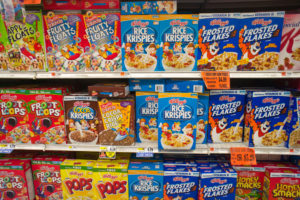 Why do Americans eat what they eat? It is not merely a matter of personal preference and bad choices. Corporations actually spend millions upon millions of dollars to sell sugar and unhealthy foods to the public, and these companies make particular appeals to Black and Brown people.
Why do Americans eat what they eat? It is not merely a matter of personal preference and bad choices. Corporations actually spend millions upon millions of dollars to sell sugar and unhealthy foods to the public, and these companies make particular appeals to Black and Brown people.
In his recent piece in The Atlantic, called “The Money Spent Selling Sugar to Americans Is Staggering,” James Hamblin lays the groundwork. In his analysis, he uses the example of Pumpkin-pie Pop Tarts. The labeling boasts that the sugary snack is “made with real nutmeg, cinnamon, and clove” to give the impression it is healthy, illustrating how the processed food industry appeals to consumers and makes them feel certain things.
Hamblin argues that “the most urgent barriers to a just American food experience were not matters of metabolism, but of access and inequality, of the politics of lobbying, of the language of marketing, and of the deeply funded and subsidized, strategically crafted emotional appeal of Pop Tarts.” The culprits are effective advertising and lobbying.
For example, Kellogg’s spent $32 million in 2014 just to market Pop Tarts, while Coca-Cola spent $269 million advertising its most popular drink, and Pepsi spent $150 million in advertising for Gatorade, which is really colored sugar water for athletes.
“Think about what that money could do for education, for social welfare,” said Marion Nestle, professor of nutrition, food studies, and public health at New York University. “But that money is spent getting people to buy sugar.”

While the supermarket displays are arranged to entice the public into buying sugar, people do not have access to certain kinds of flavor, the flavors associated with real food, fruits and vegetables. Consumers should have more access to real food in order to make more healthy decisions, but rather government policy is stacked up to the detriment of consumers, as Hamblin notes. Although half of the food we eat should be fruits and vegetables, less than half of all agricultural subsidies doled out between 2o08 and 2012 went to the growing of fruits and vegetables. Moreover, the government spent four times as much on subsidies to tobacco companies.
Although we should eat as many fruits and vegetables as possible, fruits, vegetables and nuts are labeled as “specialty crops” by the U.S. Department of Agriculture. Hamblin also notes that less than five percent of the land is allocated for growing fruits and vegetables, while more than half of the land is used for growing soybeans and corn for animal feed and to make refined sugar.
 The strategies employed by these corporations, in cooperation with the government, have a pronounced impact on communities of color. For example, through ethnically-targeted advertising, junk food ads are geared towards African-American and Latino children and teens, who are twice as likely to view a commercial for soda and sugary drinks, candy, gum or savory snacks than their white peers. On the other hand, ads featuring yogurt, juice, water, fruits and vegetables and other more health-conscious snacks are aired on stations with a low Black and Latino viewership. Further, over two-thirds of Spanish-language commercials targeting Latino children promoted junk food, while only 3 percent promoted healthy food options. In one study, of the 18 percent of brands that marketed to youth, 71 percent targeted Blacks and Latinos, with the most popular brands among Blacks being Pop Tarts, Doritos and Skittles.
The strategies employed by these corporations, in cooperation with the government, have a pronounced impact on communities of color. For example, through ethnically-targeted advertising, junk food ads are geared towards African-American and Latino children and teens, who are twice as likely to view a commercial for soda and sugary drinks, candy, gum or savory snacks than their white peers. On the other hand, ads featuring yogurt, juice, water, fruits and vegetables and other more health-conscious snacks are aired on stations with a low Black and Latino viewership. Further, over two-thirds of Spanish-language commercials targeting Latino children promoted junk food, while only 3 percent promoted healthy food options. In one study, of the 18 percent of brands that marketed to youth, 71 percent targeted Blacks and Latinos, with the most popular brands among Blacks being Pop Tarts, Doritos and Skittles.
It is no wonder that the health disparities in communities of color are great, as Black and Latino children are more likely to suffer from obesity and health-related issues. In addition, greater trans-fatty acids in the diet, which interfere with omega-3 metabolism, are linked with increased depression, aggression and rage.
Meanwhile, food apartheid is a reality in the Black community, where food is a killer like drugs. “Whites only” communities have access to farmers’ markets and organic food stores, while fast food proliferates Black neighborhoods.
Healthy bodies mean healthy minds, and the predominance of unhealthy options in the African-American community has a deleterious effect on the intellectual development of Black children and their educational success.

















